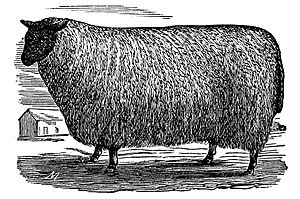Shropshire sheep facts for kids
The Shropshire sheep breed comes from the hills of Shropshire, England. It started in the 1840s when local farmers mixed their black-faced sheep with white-faced breeds like the Southdown and Cotswold. This mix created a medium-sized sheep without horns, known for both its good wool and tasty meat. The first Shropshire sheep arrived in the United States in 1855. Today, these sheep are mostly raised for their meat.
Contents
How the Shropshire Breed Began
Early History in England
In 1859, the Royal Agricultural Society of England officially recognized the Shropshire as its own special breed. It quickly became very popular in England. By 1882, Shropshire breeders created the world's first group for sheep breeders, called the Shropshire Sheep Breeders' Association. They also started publishing a "Flock Book" each year, which lists all the sheep bred and their owners. This group still exists and publishes the book every year!
Shropshire Sheep Come to America
By 1884, more Shropshire sheep were shown at local fairs than all other sheep breeds combined. The first group of Shropshire sheep in the United States arrived in Maryland in 1860. After that, thousands more were sent to the US, Australia, New Zealand, and South America. These sheep were popular because they could live well in many different places and were good for both wool and meat.
In 1884, the American Shropshire Registry was formed. By the early 1900s, the Shropshire was the most common sheep breed in the United States.
Changes Through the Years
Shropshire Sheep in the 1900s
In the 1930s, the Shropshire was known as "the farm flock favorite" in the US. However, in the 1940s, American breeders started to make Shropshires with more wool and smaller bodies. This meant the sheep had too much wool around their eyes, making it hard for them to see. Farmers had to trim the wool often. Because of this problem and their smaller size, fewer farmers wanted them. The Shropshire breed became less popular and even rare around the world.
Bringing Back the Original Traits
In the 1950s, some breeders decided to bring back the original traits that made Shropshires so great. They brought in larger, "open-faced" Shropshire rams from England. "Open-faced" means less wool around the eyes. This helped create sheep that were medium-sized again and good for both wool and meat. The Shropshire sheep started to become popular again because they could adapt to different environments.
Modern Shropshire Sheep
Even though they were very popular long ago, traditional Shropshire sheep are now considered rare in most countries. But the modern Shropshire is becoming popular again, especially as a show sheep in the Midwestern US. They are gentle and medium-sized, which makes them a favorite for young people in programs like 4-H.
Adult male Shropshires (rams) usually weigh between 225 and 250 pounds. Adult females (ewes) weigh between 150 and 180 pounds. Modern American Shropshires look quite different from the older, traditional type, with longer legs and necks.
Shropshire Sheep and Christmas Trees
In the 1990s, something interesting was discovered: Shropshires were the only sheep breed that wouldn't nibble on Christmas trees or bite the bark off fruit trees! This made them very useful for Christmas tree farmers. They help keep the grass short, so farmers don't need to use weed killers. Plus, their droppings act as good fertilizer for the young trees.
What a Shropshire Sheep Looks Like (Traditional Type)
General Appearance
A traditional Shropshire sheep looks alert and attractive. It stands nicely and has a balanced body covered with fine, thick wool. They move freely and have strong, smooth shoulders. They have a full chest and a strong, straight back.
Size and Weight
These are medium-sized sheep. Fully grown rams (males) should weigh between 180 and 240 pounds. Ewes (females) should weigh between 140 and 200 pounds.
Wool and Skin
Their wool is long, thick, and feels springy. It should be medium-fine, without any black fibers, and have an even texture. The skin should be a light cherry color, clear, and without dark spots.
Body Shape
Shropshire sheep have a well-muscled, long, deep, and balanced body. Their shoulders are strong and blend smoothly into their body. They have a deep and wide chest, strong forearms, and a long, broad, straight back. Their ribs are well-sprung, and their loins (lower back) are thick and wide. Their hips are wide and smooth, and their hindquarters are well-developed with full, deep legs.
Head and Neck
The head is short and wide between the ears and eyes. Rams have a bold, masculine head without horns. The face can be straight or slightly dished (curved inward). They have a broad muzzle. White, thick wool covers the top of the head, cheeks, and jaw. Their eyes are bright and alert. The face and ears are dark brown, and some grey hairs on the nose are okay. The neck is short, strong, and muscular, especially in rams, connecting the head and shoulders smoothly.
Ears
Their ears are short, alert, and set well, pointing out rather than straight up. They are moderately thick and the same color as the face and legs (cinnamon to dark brown or soft black). The tips are rounded, and wool covers the outside of the ear.
Legs and Feet
The legs are strong, short, straight, and well-covered with wool. The hair on the legs is dark chocolate brown, and the wool on the legs is white. Their feet are strong, with short hooves, and are set squarely under the sheep.
Images for kids







